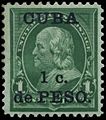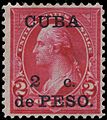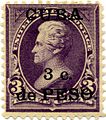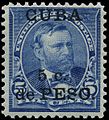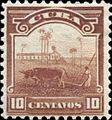Postage stamps and postal history of Cuba
You can help expand this article with text translated from the corresponding article in Russian. (February 2015) Click [show] for important translation instructions.
|

This is a survey of the postage stamps and postal history of Cuba.
First stamps and postal stationery

The first stamps of Cuba were issues for the
Cuba had separate stamps from 1873.
-
An 1873 stamp depicting King Amadeo I.
-
An 1878 stamp depicting KingAlfonso XII.
-
An 1891 stamp depicting KingAlfonso XIIIas a baby.
-
An 1898 stamp depicting KingAlfonso XIII.
-
The first CubanKing Alfonso XII.
-
Cuban newspaper stamps of 1896 with el pelón portrait of Alfonso XIII.
U.S. intervention

The United States intervened in Cuba in 1898. One of the interesting and rare series of stamps occurred as a result. This was the
In December 1898, Major Estes Rathbone was appointed Director General of Posts for Cuba and on January 1, 1899, the U.S. established a Cuban Civilian Postal Administration. The new Postal Administration was to operate using the same post offices that existed during the Spanish Administration, but using its new postage stamps and canceling devices. Since January 1 was a Sunday, the recently received U.S. Stamps overprinted for use in Cuba did not go on sale in Havana until Monday, January 2. Outlying areas received the overprinted stamps later.
The provisional stamp overprints on U.S. stamps initially consisted of a 1 centavo on a 1¢ Franklin, 2½c on a 2¢ Washington, 3c on a 3¢ Jackson, 5c on a 5¢ Grant, 10c on a 10¢ Webster and a 10c overprint on a U.S. special delivery stamp. It turned out that the 2½¢ stamp was in error as the postage rates had recently changed. They continued to use the 2½¢ stamps anyway and sold them for and valued them at 2¢ so as not to waste the large printing. Later a 2¢ overprint appeared.
-
Provisional overprint for Cuba, 1899.
-
Provisional overprint for Cuba, 1899.
-
Provisional overprint for Cuba, 1899.
-
Provisional overprint for Cuba, 1899.
-
Provisional overprint for Cuba, 1899.
-
Provisional special delivery overprint for Cuba, 1899.
Later in 1899, the United States printed a series of six stamps for Cuba. They are known as the "Alegorías Cubana" or Cuban allegory stamps. Regular postage rates of 1¢, 2¢, 3¢, 5¢ and 10¢ and a special delivery 10¢ stamp comprised this series.
-
An 1899 stamp depicting Columbus.
-
An 1899 stamp depicting the Cuban royal palms.
-
An 1899 stamp depicting the personification of Cuba.
-
An 1899 stamp featuring a steamship.
-
An 1899 stamp featuring a field plowed by oxen.
-
An 1899 special delivery stamp featuring a messenger on bicycle.
As with the adhesive stamps, the first provisional stamped envelopes were also overprints on U.S. stock. There were eight different U.S. envelopes that were overprinted "CUBA." and "1c. (or 2c.) DE PESO.". By the late summer of 1899, the U.S. had furnished Cuba with its own Columbus design to replace the overprints. Likewise the first (and only) postal cards of the U.S. administration were a 1¢ U.S. Jefferson card overprinted with "CUBA.-1c. de Peso." and a 2¢ U.S. Liberty card overprinted with "CUBA.-2c. de Peso.".[6]
U.S. rule of Cuba ended on May 20, 1902, when Cuba became an independent Republic.
Cuban Republic stamps

The Cuban government of the República de Cuba issued stamps from its inception in 1902 until Fidel Castro assumed control on January 1, 1959. The first issue was on September 30, 1902. There were no stamps yet printed by Cuba, but they had many of the little used 3¢ allegory stamps of 1899. They choose to overprint these stamps to meet the 1¢ postal rate demand by overprinting a large numeral "1" on each stamp with the legend "UN CENTAVO" "HABILITADO" and "OCTUBRE 1902". Cubans continued to use the allegory stamps of 1899. In 1905, four of the five regular rate allegory stamps were reprinted for Cuba in the United States, but this time the printer made minute changes in each of the stamps before the reprint so as to make them distinguishable.[1]
The last stamps of the Republic before the revolution were the Christmas 2¢ and 4¢ issues of December 16, 1958. Judging by the
Socialist era
With the coming of the Cuban Revolution, the stamps of Cuba proliferated in number.[8] Topical stamps abound, as do postal cards. About thirty aerograms have been produced.[9] The postal stationery Mother's Day cards number have been produced in numbers of 20 or more per year and now number in the hundreds.[8][10]
References
- ^ ISBN 84-95019-08-6
- ^ "Spanish West Indies | Stamps and postal history | StampWorldHistory". Archived from the original on 2018-05-04. Retrieved 12 August 2018.[title missing]
- ISBN 0-356-10862-7
- ^ "Cuba | Stamps and postal history | StampWorldHistory". Archived from the original on 2017-12-14. Retrieved 12 August 2018.[title missing]
- ISBN 978-0-9800112-4-1
- ^ ISBN 978-0-9800112-3-4.
- ^ Andreini, J.M. Puerto-Principe, An Interesting Issue of Stamps in Cuba. Blue Sky Press, 1904.
- ^ a b Edifil; Catálogo Especializado de Sellos de Cuba, Tomo II (1959-2005), Madrid, 2005 (in Spanish).
- ^ "Aerograms (1957-present) on exhibit pages of International Cuban Philatelic Society". Archived from the original on 2011-02-11. Retrieved 2010-12-01.
- ISBN 978-0-8223-4199-4.







